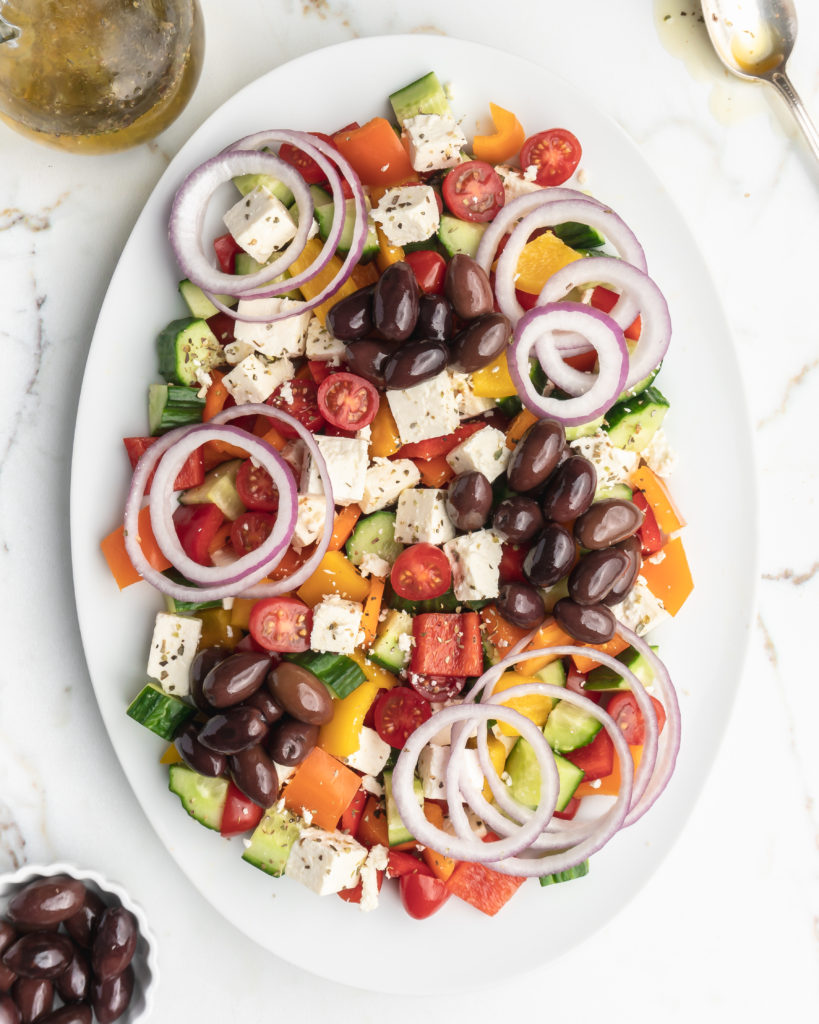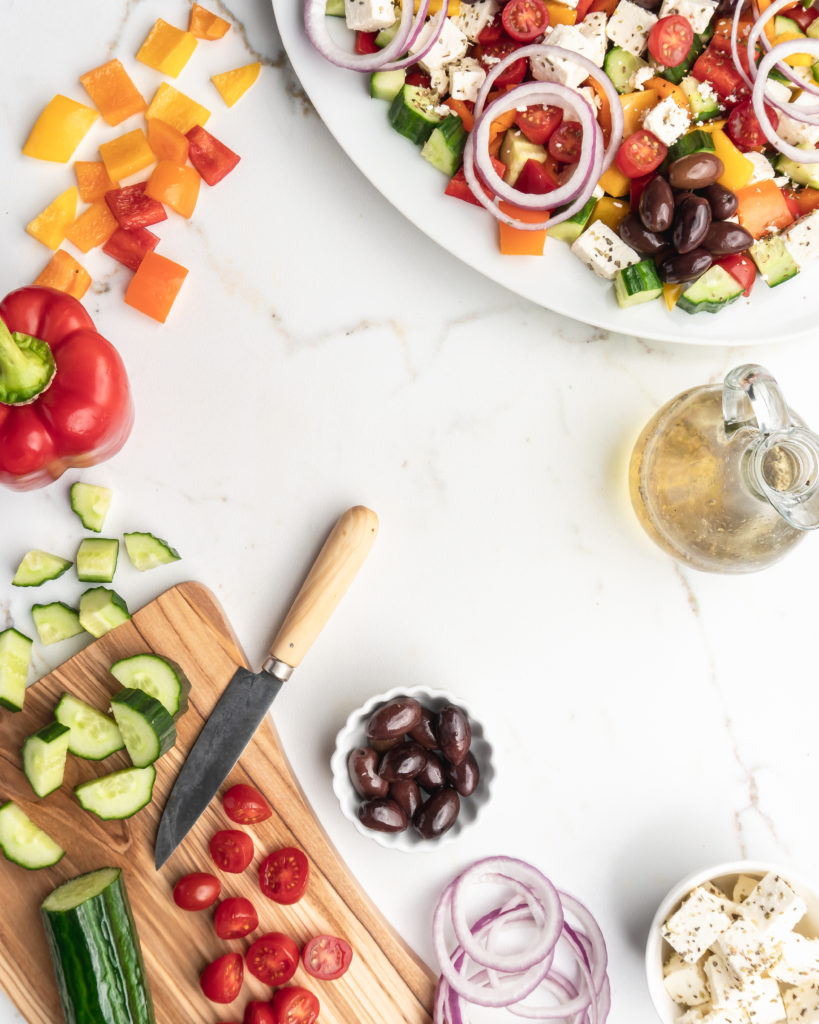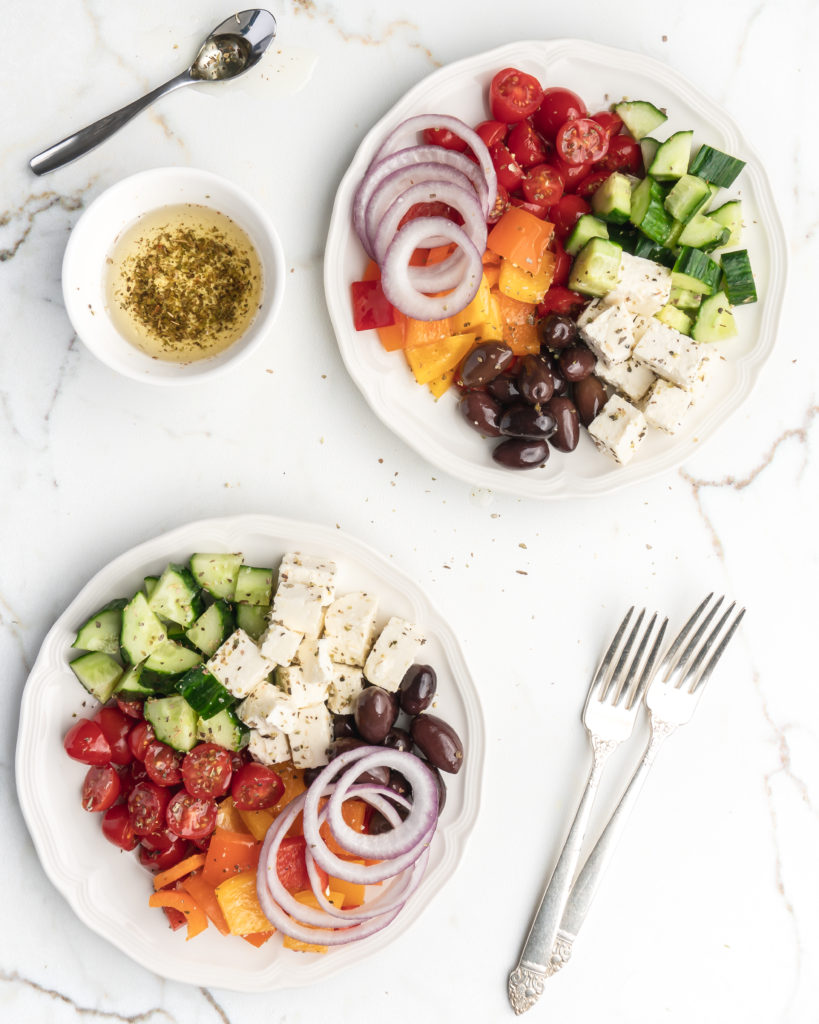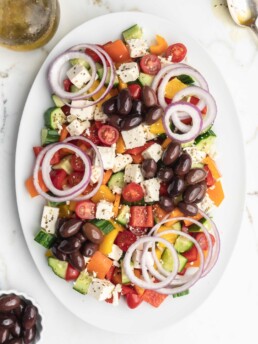Greek Salad with Homemade Dressing
This Easy Greek Salad with homemade dressing is everything you want in a salad! Full of fresh vegetables, savory olives, and of course salty feta, this Greek Salad is absolutely incredible! Stolen from my mom, this salad features a homemade dressing that is unbelievably simple, but still full of flavor. I’m telling you, this will soon become your go-to side salad!

Red Onions vs Other Onions
This salad makes use of red onions, but have you ever wondered what the difference is between all the different varieties of onions, namely white vs yellow vs red? Well, white onions are definitely the most pungent and strongly flavored onion of the bunch. While yellow onions are a great general onion, with strong but not overpowering onion-y taste. Sweet onions are very mild and have a meaty texture. Red onions are mild and sweet, like their Sweet Onion cousin, but also have a great crispy, crunchy texture that makes them perfect in salads! Besides, their color and vibrancy is unmatched, making them so visually appealing for salads!

What is Umami?
If you’ve ever heard the word umami, and wondered – what the heck is that?? You’re not alone! Umami is the “5th taste”, behind salty, sweet, sour, and bitter. Umami adds a meaty savouriness to dishes, as well as a great deal of depth which can’t be achieved otherwise. Umami is a standalone flavor by itself, but umami’s greatness lies in its ability to enhance other flavors! Umami is essentially the fancy term for tasting glutamate. Glutamate is an amino acid that is detected on our tongues by specialized receptors. Glutamate produces a meaty, savory taste on our tongues, which greatly enhances and compliments the other flavors in a dish. This is why MSG, which is the man-made sodium salt of glutamate, makes things taste good! To unlock a food’s (which is naturally high in glutamate) umami potential, it is typically imperative to either cook it or ferment it. These processes release the amino acids in the foods, making them available for tasting. This is why uncooked meat lacks flavor, while cooked meat is ultra-savory, as well as why milk is relatively bland but fermented cheese is full of savory flavors!
Another great thing about umami is that when you combine umami-laced ingredients, it actually has an exponential effect on flavor. Umami intensifies saltiness and sweetness, while simultaneously balancing out sourness and bitterness. As Laura Santtini says “1+1=8” when it comes to umami. You can have multiple high-umami foods that are very different, but somehow they not only compliment one another, but actually amplify each other’s flavor! The example she gives is tomatoes, beef, and parmesan cheese. All high in umami, all great by themselves, but combine them to make Bolognese sauce and the result is mind-blowingly good!
If you’re wondering why all this matters, its because this salad has amazing umami flavors! Olives are one of the highest umami foods out there! And, as mentioned before, cheese is super high in umami as well, which is surely why Greek salad is beyond delicious.

Variations of Ingredients
As a last little note, I wanted to give a few variations that can be used in this salad:
- Either white balsamic vinegar or traditional balsamic vinegar are fine! While white balsamic vinegar is technically not actually true balsamic vinegar, the flavor is there and pairs nicely with this salad. White balsamic vinegar will look better, but true dark balsamic vinegar is slightly sweeter and more traditional, but not quite as clean looking.
- I actually tend to use goat feta in my Greek salad. I absolutely love the more pungent taste of goat feta, however if you prefer cow feta, that is your prerogative.
- The recipe calls for cherry/grape tomatoes, however if you want to use roma/plum tomatoes that is fine as well. The only drawback of using roma/plum tomatoes is that they do not store well. The salt in the salad will cause the tomatoes to release their juices, so when you go to eat the leftovers they can be quite watery. If I know I am going to have leftovers, I actually wont even slice the grape/cherry tomatoes in half either. When they are left whole I do not find the salad becomes watery at all after storing.
- Lastly, I quite enjoy adding a drizzling of balsamic reduction to the Greek salad. I just buy balsamic reduction at my local grocery store, and then right before serving I drizzle a small amount over the plated salad. I find it adds a nice sweetness and aesthetic quality.

Get the Recipe: Greek Salad with Homemade Dressing
Ingredients
Greek Salad
- 2 Bell Peppers (Red, Orange, Yellow),, washed, de-seeded, and coarsely chopped
- 1 English Cucumber, , washed and sliced into rounds and then quartered
- 1 cup Cherry or Grape Tomatoes, , washed, and left whole or sliced in half
- 1/2 Small Red Onion,, peeled and sliced into strips
- 1 cup Chopped Feta Cheese
- 1 cup Kalamata Olives,, whole or pitted
- Greek Salad Dressing (Below)
- (Optional) Drizzling of Balsamic Reduction
Greek Salad Dressing
- 4 tbsp Quality Extra Virgin Olive Oil
- 4 tbsp Quality Balsamic Vinegar,, white or traditional
- 2 tsp Dried Oregano
- 1 tsp Feta Brine
- 1/2 tsp Kosher Salt
- 1/4 tsp Freshly Ground Black Pepper
Instructions
Greek Salad
- Add all the vegetables, feta, and olives to a large bowl. Add the salad dressing, then toss to combine.
(Optional) Drizzle top with balsamic reduction.
Greek Salad Dressing
- Add all the ingredients to a medium sized bowl. Using a whisk, mix all the ingredients together vigorously until they are well emulsified.
- (Optional) For easy emulsifying, add all salad dressing ingredients to a jar with a lid. Place lid on jar and shake vigorously.

